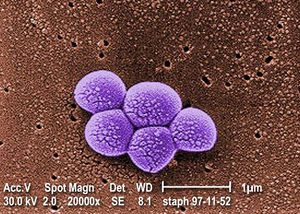Hantaviruses: Old World vs. New World
Hantaviruses

By Raphael A. Melo
At right is a sample image insertion. It works for any image uploaded anywhere to MicrobeWiki.
The insertion code consists of:
Double brackets: [[
Filename: PHIL_1181_lores.jpg
Thumbnail status: |thumb|
Pixel size: |300px|
Placement on page: |right|
Legend/credit: Magnified 20,000X, this colorized scanning electron micrograph (SEM) depicts a grouping of methicillin resistant Staphylococcus aureus (MRSA) bacteria. Photo credit: CDC. Every image requires a link to the source.
Closed double brackets: ]]
Other examples:
Bold
Italic
Subscript: H2O
Superscript: Fe3+
Sample citations: [1]
[2]
A citation code consists of a hyperlinked reference within "ref" begin and end codes.
To repeat the citation for other statements, the reference needs to have a names: "<ref name=aa>"
The repeated citation works like this, with a forward slash.[1]
Hantaviruses
Background
Hantaviruses belong to the viral family Bunyaviradae, of which there are five genera: bunyavirus, phlebovirus, nairovirus, tospovirus, and hantavirus (HTV). Bunyaviruses, phleboviruses, nairoviruses, and tospovirus, while hantaviruses use rodent vectors. Although there is no definitive number, there are around 35 known species of HTV that currently exist in the world, including both old-world and new-world strains. Hantaviruses are typically able to infect humans via urine and fecal matter of rodents (Clement et al., 2006). When bedding covered in rodent waste is disturbed, the waste particles become aerosolized and are able to be inhaled, potentially leading to infection (Clement et al., 2006). Most infections and outbreaks arise within conditions that allow for these particles to become aerosolized, such as during land development, agriculture, and urbanization (CDC, 2021). The first recorded strain was documented as the Hantaan strain, an Old-World variant, between 1951 and 1953 in Korea, and was the first species of many to be documented since. Infecting more than 3000 Korean soldiers during the Korean war, the Hantaan virus outbreak was located near the Hantan river, providing the virus with its name that would later represent all future variants (Mir, 2010). In regards to healthcare, there is no effective cure or treatment for HTV (CDC). Patients will typically receive a broad range of antibiotic therapies and supportive care while being closely monitored (CDC). In regards to treatment based on the type of HTV, there are generally different procedures and drugs administered based on whether or not the species of HTV is “Old World” or “New World."
Section 2
Include some current research, with at least one figure showing data.
Section 3
Include some current research, with at least one figure showing data.
Section 4
Conclusion
References
Authored for BIOL 238 Microbiology, taught by Joan Slonczewski,at Kenyon College,2024
